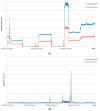Children's Personal Exposure Measurements to Extremely Low Frequency Magnetic Fields in Italy
- PMID: 27258295
- PMCID: PMC4924006
- DOI: 10.3390/ijerph13060549
Children's Personal Exposure Measurements to Extremely Low Frequency Magnetic Fields in Italy
Abstract
Extremely low frequency magnetic fields (ELF-MFs) exposure is still a topic of concern due to their possible impact on children's health. Although epidemiological studies claimed an evidence of a possible association between ELF-MF above 0.4 μT and childhood leukemia, biological mechanisms able to support a causal relationship between ELF-MF and this disease were not found yet. To provide further knowledge about children's ELF-MF exposure correlated to children's daily activities, a measurement study was conducted in Milan (Italy). Eighty-six children were recruited, 52 of whom were specifically chosen with respect to the distance to power lines and built-in transformers to oversample potentially highly exposed children. Personal and bedroom measurements were performed for each child in two different seasons. The major outcomes of this study are: (1) median values over 24-h personal and bedroom measurements were <3 μT established by the Italian law as the quality target; (2) geometric mean values over 24-h bedroom measurements were mostly <0.4 μT; (3) seasonal variations did not significantly influence personal and bedroom measurements; (4) the highest average MF levels were mostly found at home during the day and outdoors; (5) no significant differences were found in the median and geometric mean values between personal and bedroom measurements, but were found in the arithmetic mean.
Keywords: children; exposure assessment; extremely low frequency magnetic fields (ELF-MF); personal measurement; power line; transformer.
Figures







Similar articles
-
Characterization of Children's Exposure to Extremely Low Frequency Magnetic Fields by Stochastic Modeling.Int J Environ Res Public Health. 2018 Sep 8;15(9):1963. doi: 10.3390/ijerph15091963. Int J Environ Res Public Health. 2018. PMID: 30205571 Free PMC article.
-
Analysis of personal and bedroom exposure to ELF-MFs in children in Italy and Switzerland.J Expo Sci Environ Epidemiol. 2016 Nov;26(6):586-596. doi: 10.1038/jes.2015.80. Epub 2015 Dec 16. J Expo Sci Environ Epidemiol. 2016. PMID: 26669849
-
Extremely Low-Frequency Magnetic Fields and the Risk of Childhood B-Lineage Acute Lymphoblastic Leukemia in a City With High Incidence of Leukemia and Elevated Exposure to ELF Magnetic Fields.Bioelectromagnetics. 2020 Dec;41(8):581-597. doi: 10.1002/bem.22295. Epub 2020 Sep 23. Bioelectromagnetics. 2020. PMID: 32965755
-
Characteristics of Peak Exposure of Semiconductor Workers to Extremely Low-Frequency Magnetic Fields.Ann Work Expo Health. 2023 Apr 21;67(4):508-517. doi: 10.1093/annweh/wxad003. Ann Work Expo Health. 2023. PMID: 36857508 Review.
-
[Health effects of electromagnetic fields].Ther Umsch. 2013 Dec;70(12):733-8. doi: 10.1024/0040-5930/a000472. Ther Umsch. 2013. PMID: 24297859 Review. German.
Cited by
-
50 Hz Temporal Magnetic Field Monitoring from High-Voltage Power Lines: Sensor Design and Experimental Validation.Sensors (Basel). 2024 Aug 17;24(16):5325. doi: 10.3390/s24165325. Sensors (Basel). 2024. PMID: 39205019 Free PMC article.
-
Characterization of Children's Exposure to Extremely Low Frequency Magnetic Fields by Stochastic Modeling.Int J Environ Res Public Health. 2018 Sep 8;15(9):1963. doi: 10.3390/ijerph15091963. Int J Environ Res Public Health. 2018. PMID: 30205571 Free PMC article.
-
Review of Studies Concerning Electromagnetic Field (EMF) Exposure Assessment in Europe: Low Frequency Fields (50 Hz-100 kHz).Int J Environ Res Public Health. 2016 Sep 1;13(9):875. doi: 10.3390/ijerph13090875. Int J Environ Res Public Health. 2016. PMID: 27598182 Free PMC article. Review.
-
Magnetic Fields and Cancer: Epidemiology, Cellular Biology, and Theranostics.Int J Mol Sci. 2022 Jan 25;23(3):1339. doi: 10.3390/ijms23031339. Int J Mol Sci. 2022. PMID: 35163262 Free PMC article. Review.
References
-
- Steliarova-Foucher E., Stiller C., Kaatsch P., Berrino F., Coebergh J.W., Lacour B., Parkin M. Geographical patterns and time trends of cancer incidence and survival among children and adolescents in Europe since the 1970s (the ACCIS project): An epidemiological study. Lancet. 2004;36:2097–2105. doi: 10.1016/S0140-6736(04)17550-8. - DOI - PubMed
-
- Wertheimer N., Leeper E. Electrical wiring configurations and childhood cancer. Am. J. Epidemiol. 1979;109:273–284. - PubMed
MeSH terms
LinkOut - more resources
Full Text Sources
Other Literature Sources
Medical

